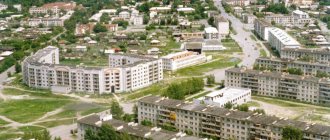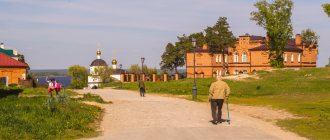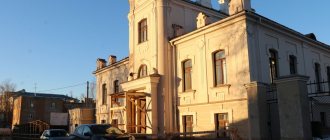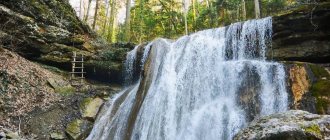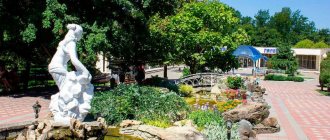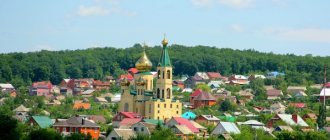Bilyarsk: areas, recreation, excursions, museums and churches, cuisine and restaurants, shopping and shops, attractions of Bilyarsk.
- May tours
to Russia - Last minute tours
to Russia
It looks like Bilyarsk is a village like a village, there are dozens of them in Tatarstan. But it is Bilyarsk that stands on the site of the ancient capital of Volga Bulgaria. This is a place of power that is recognized by people of different faiths. Eight hundred years ago, the name Bilyar was borne by one of the largest medieval cities - with an area of almost 800 hectares, with a population of up to 70 thousand people. It was larger and larger than Paris and London! Bilyar was a major center of industry, crafts, trade, and culture. And in Russian chronicles it is called the “Great City”. Metallurgists, blacksmiths, masons, tanners, jewelers, carpenters lived here... Trade routes from Central Asia and Iran, Rus' and the Baltic states, the Caucasus and Byzantium converged in Bilyar. Merchants stayed in caravanserais; the ruins of one of them have survived to this day.
How to call
+7-84341 - phone number
Bilyarsk - resume
As you might have already guessed, Bilyarsk is clearly not a place where you should go purposefully.
The Holy Key may probably be of interest to pilgrims and believers, and, if you believe the description, to both Christians and Muslims, but this, I repeat, is formally no longer Bilyarsk. By the way, they also offer bus excursions from Kazan to Klyuch. The settlement itself will be of interest, first of all, to archaeologists, and taking into account the fact that there is nothing interesting there for the average person, I would generally cover these foundations with earth from sin, as was done, for example, at the Truvorov settlement in Izborsk. Well, if it makes sense to go to Bilyarsk for a couple of small museums, then, again, only if you purposefully collect information on ancient Bilyar or the biography of the chemist Arbuzov.
Nevertheless, I personally do not regret that I passed through Bilyarsk. But, again, not thanks to Bilyarsk itself - it was only an occasion to look at Tatarstan outside the main tourist routes. And yes, the fields and landscapes of the Tatar Republic were very memorable to me, but if Bilyarsk had not been on my route, they would probably have been no less memorable.
Bilyarsk and Svyatoy Klyuch - interesting facts
- In Bilyarsk there is the grave of the famous chemist Alexander Butlerov, as well as the house-museum of the chemists Arbuzov.
- According to one version, the Mongols could not capture the city for a long time and took it by cunning. They caught all the surrounding pigeons and tied burning rags to them. Frightened birds returned to the city and sat on the roofs. While residents were putting out fires, the Mongols launched an attack.
- According to one unconfirmed version, Bilyarsk was so rich that the entrance to it was through a gate made of pure gold.
- In Bilyarsk there is a site for traditional Muslim sacrifices - rams, chickens, and geese are slaughtered.
Bilyarsk is a place with bright and strong energy; people come here to take a walk, pray, gain strength and tie a ribbon on the spruce tree near the Wishing Stone. No matter who you are or what you believe, this place welcomes everyone.
If you find any inaccuracies in the material or have any additions, be sure to write in the comments!
Local Lore Museum of Bugulma
The building was built at the end of the eighteenth century, but the museum was officially opened only in the 20-30s of the twentieth. This museum is one of the oldest in all of Tatarstan. The museum contains documents relating to all events that occurred after its founding.
There are special documents and archival materials on the Pugachev uprising, evidence of the Civil and Great Patriotic Wars, outfits of various class categories and nationalities, household utensils and other household items, as well as goods from fairs dating back to the nineteenth century. This museum will be very educational for those who are truly passionate about the history of this city and its people.
Location: Herzen Street - 88.
Seven Wonders of Russia
The Valley of Geysers, located in the Kamchatka Territory, became one of the wonders of Russia according to this competition. Discovered in 1941 by geologists of the Kronotsky Nature Reserve, the valley was recognized as a unique natural object, concentrating dozens of hot springs - geysers - in a small area. The appearance of the Valley of Geysers is constantly changing - both under the influence of natural disasters and as a result of human activity: some geysers discovered in the forties no longer exist, others, on the contrary, have appeared.
Another natural object and winner of the competition is Lake Baikal, located in the Irkutsk region and the Republic of Buryatia. This is the deepest lake in the world, and it appeared 25-30 million years ago as a result of a fracture in the earth’s crust. The water in Baikal is so clean that at a depth of 40 meters you can clearly see the bottom. Many species of plants and animals are not found anywhere else - they are endemic to Lake Baikal.
One of the wonders of Russia was also found in the capital - this is St. Basil's Cathedral, or the Cathedral of the Intercession of the Blessed Virgin Mary, which is on the Moat. Built in 1555-61 by order of Ivan the Terrible and to commemorate the annexation of the Kazan Khanate, it for a long time became not only the most beautiful, but also the tallest building in the city. Over time, the appearance of the cathedral changed significantly several times, especially significant was the reconstruction under Catherine II, carried out after the fire in 1737, when the temple almost completely burned down.
Tourist streets
The following streets are best suited for walking for tourism purposes:
- Smirnova - goes along the length of the Archaeological Reserve. There are a large number of old houses on it, which, according to the state program for the preservation of Bulgarian culture, were restored at the beginning of 2010. The street bears its name in honor of the scientist archaeologist, under whose leadership many discoveries were made, artifacts of the Middle Ages were found that tell about the past of the ancient people.
- Likhachev - the outskirts of the street, where ancient buildings have also been preserved, conveying the spirit of history. The street is long, so it will require a hiker to be in good physical shape in order to cover the entire length of the walking route and see the architectural ensemble of house buildings in a short period of time.
- Gordeeva is another pedestrian street that will also be of interest to travelers visiting Bulgar for tourism purposes. This is the part of the city where the archaeological reserve originates. The largest attraction of the Bulgars. If you follow Gordeeva straight ahead and don’t turn off, then Smirnova Street begins.
Each of them is interesting in its own way, has a unique flavor, a significant number of old houses and features. It is recommended to arm yourself with a map and explore the surrounding streets, which will also be no less interesting than the walking routes described above.
What to see in the area
Bulgars (Tatarstan and the city’s attractions are not limited exclusively to the central part) in its vicinity have a large number of interesting places of historical value.
They are:
- Bilyarsk was previously an ancient settlement of Volga Bulgaria called Bilyar. Nearby is the rural settlement of Arbuzov-Baran, where you can visit a museum dedicated to the Russian chemist Alexander Arbuzov. The scientist lived in this region for a long time. Tourists are offered to try the local water, which has healing properties.
- Kuznechikha is a village, next to which there are the ruins of the ancient city of Suvar, which existed at the same time as Bolgar. In Kuznechikha there is a small museum where tourists can see archaeological finds telling about the history of the Suvara settlement. The cost of entrance tickets is 50-60 rubles, but it is recommended to check with the seller on site.
- Dolgaya Polyana is located near the outskirts of Bolgar, located on the neighboring bank of the Volga. There are not only beautiful natural landscapes here, but also the estate of the Molostvov family.
It is possible that during an independent journey through the outskirts of Bolgar, someone will discover other equally interesting objects of tourist, historical and archaeological value. This region is rich in artifacts from all eras.
Excursions
Bolgar is a small town aimed at tourists who want to replenish their luggage with new knowledge of the history of this region.
The number of excursion routes is insignificant, but you can still use the following directions:
| Excursion name | Description |
| Kazan - Bolgar |
|
| Bulgarian settlement |
|
| Bulgarian Orthodox |
|
In addition to the sights of Bulgar, you can see the landscapes of the Republic of Tatarstan by taking a boat ride along the Volga River. The route is chosen independently or with the help of a guide. It is enough to arm yourself with a map, plot your route, purchase a boat ticket and set off along the coastline of the republic.
Article design: Oleg Lozinsky
Churches and temples
The official religion of the Republic of Tatarstan is Islam. Despite this, Orthodox churches, temples and prayer rooms operate on the territory of Bulgar.
For connoisseurs of the spiritual aspects of life, you can visit religious attractions, namely:
- St. Abraham's Church was opened in 1988 in honor of the anniversary of the baptism of Kievan Rus. The temple was not built directly in the city. Initially it was located 15 km from Bulgar in the village of Porfirovka. The church was founded by a priest - Father Sergius. Previously, there was a small prayer house here, but through the efforts of the local community, the church was moved and is still in operation today. The temple received its name in honor of the Bulgarian martyr and saint - Abraham.
- Trinity House of Prayer is a small parish of Orthodox believers who have their own spiritual father who conducts services every Sunday, as well as on religious holidays. It is distinguished by its beautiful design, a large number of icons that were purchased or made by parishioners of the temple.
- The well of the holy martyr Abraham, who is also called the Wonderworker of Vladimir, is a source of healing water, near which a small church was built. Every believer who professes Orthodoxy can drink holy water, and then light a candle and pray.
- Assumption Church - currently, liturgies and holiday services are not held in this temple. The church is open to the public as a historical and architectural landmark. It will be of interest to tourists who are interested in the development of Orthodoxy on the territory of the oldest Muslim city in the Republic of Tatarstan.
In addition to Orthodox shrines, tourists visiting Bulgar will be interested in seeing the White Mosque. It was reconstructed in 2010 with the support of the top officials of the leadership of the Republic of Tatarstan. Additional extensions were erected to the main mosque, which replicate the architectural ensemble of Kul-Sharif. This is a mosque located in the capital of the republic - Kazan.
Bilyarsk
The village was founded in 1654 on the site of the Bulgar city of Bilyar as one of the fortresses of the Zakamsk serif. The first settlers were the Streltsy, resettled with their families from the Akhtachinsky fort and allocated land in the vicinity of the village.
The Bilyarsky fort was a key point of the Zakamsky line. In 1683 it was taken and burned by Kalmyks and Bashkirs, and in 1708 it was besieged by Bashkirs and Karakalpaks.
In 1736, the Bilyar Landmilitia Regiment was formed, which was subsequently sent to the Orenburg Line (disbanded in the 1770s).
Descendants of the Polotsk gentry and white-arable Cossacks lived in Bilyarsk. Since 1736, the office of retired military personnel was located in the village (it dealt with the affairs of the settlers).
The events of the uprising led by E.I. Pugachev are connected with Bilyarsk: in 1773 - early 1774, several rebel detachments near the village were defeated by government troops.
At the end of the 18th century. The Bilyar fortress fell into disrepair and was demolished.
In the 18th – early 20th centuries. the village had the status of a suburb. In 1877–1878 severe fires destroyed most of the houses.
Until the 1860s the inhabitants belonged to the category of state peasants (former retired soldiers). The main occupations of the residents during this period were agriculture and cattle breeding; pottery and dyeing were common.
The Orthodox parish was founded in 1654, the first church was built in the 1660s. In 1796, a new wooden Archangel Michael Church with chapels in the name of the Epiphany of the Lord and Elijah the Prophet was erected. In 1877–1892 According to the design of the famous Kazan architect P.E. Anikin, the brick St. Michael the Archangel Church (in the eclectic style) was built in 1914–1915. according to the design of the architect N.M. Andreev - a bell tower (closed in 1935; destroyed in 1940).
In the first half of the 19th century. There was a private school of V.P. Obrezkov, in which children of peasants and clergy studied. In 1845, a one-class men's school was opened, which since 1863 has been under the jurisdiction of the Ministry of State Property. The first mentor of the school was the parish priest A.V. Orlov.
In 1866, the school came under the jurisdiction of the zemstvo, in 1880 it was transformed into a two-class school and came under the jurisdiction of the Ministry of Public Education. Subsequently, the zemstvo built a house for the school with two classrooms, an entrance hall, a room for a watchman and an outbuilding with two apartments for teachers. Over 200 boys studied, including from other villages (5 students received scholarships from the zemstvo).
In 1883, a male choir was formed at the school, consisting of teachers, students, a psalm-reader, and adult peasants. In the 1880s. The honorary guardian of the school was the district leader of the nobility V.I. Yakubovich.
In 1882, a Sunday revision class for 60 people was opened at the school.
In 1861, the wife of priest A.M. Lavrov opened a girls’ school (40 girls studied), which in 1866 was taken over by the zemstvo. It was located in a specially built house with a classroom and an apartment for the teacher. 70 girls and 25 boys studied. Girls were additionally taught handicrafts: sewing, knitting, embroidery; Since 1883, a women's choir operated at the school.
For more than 20 years, the daughter of its founder, A.M. Lavrova, taught at the school, and was highly respected by local residents. Thanks to her activities, the educational institution acquired an exemplary state.
At the beginning of the twentieth century. in the village there was a volost government, a volost bank, a telephone exchange, a two-year school of the Ministry of Public Education, a zemstvo school, a parochial school, a steam mill, a store, about 30 small items, a state-owned wine shop and 2 beer shops, a market on Thursdays, annual fairs ( July 13 and September 14).
During this period, the land allotment of the rural community was 10,026 acres.
Memorial of Eternal Glory
It is a memorial complex consisting of separate monuments: in front, on a small elevation, there is an eternal flame, and then there is a stele in the form of a flag, the right part of which is represented as a black mourning ribbon, and the right one contains 5560 names of heroes who gave their own lives for the defense of the Motherland and future generations from the Nazi invaders. In 2000, an armored transport and combat vehicle, the famous T-54 tank and a bomber with the inscription “Bugulma Collective Farmer” on board were fixed in front of the pedestal.
Having become more thoroughly acquainted with the history and architecture of the city, you come to the conclusion that Bugulma is one of the Russian cities that contains a huge number of monuments, steles and other buildings dedicated to the Great Patriotic War, which is so important for the younger generation to know and remember. Location: Alley of Heroes.
Location: Alley of Heroes.
Wonders of the world - old and new
But come 2007, it was decided to update the list of the most significant cultural monuments for humanity, and based on the results of a vote in which one hundred million people around the world participated (by telephone and via the Internet), new seven wonders of the world were determined. The announcement of the winners took place in Lisbon, and the date of this event was July 7, that is, 07/07/07.
UNESCO did not recognize the new list, and Egypt asked in advance not to include the Cheops Pyramid, the only surviving wonder of the world, in the vote. But the results were still met with great enthusiasm, and the tourist attractiveness of the seven winners, of course, increased even more. Here is a list of new wonders of the world: the Great Wall of China, the statue of Christ the Redeemer in Rio de Janeiro, the ancient ruined city in the mountains of Peru Machu Picchu, Petra in Jordan, the sacred Mayan city of Chichen Itza, the Roman Colosseum and the Indian Taj Mahal.
Golden Abode of Buddha Shakyamuni
The largest Buddhist temple not only in Elista, but also in Russia. The magnificent snow-white building will introduce guests to the basics of this eastern religion.
It is customary to distinguish seven levels (floors), which perform different roles. On the first one you can visit the museum of the history of Buddhist culture, a library and a souvenir shop. On the second level there is a prayer hall. On the third is the Elista administration, offices for receiving citizens.
The President of Kalmykia, Kirsan Ilyumzhinov, shares the fourth level of the monastery with the head of the Buddhists of Kalmykia, Tulku Rinpoche, and the monks. Above is the residence of the 14th Dalai Lama. This is followed by a utility part, above which you can find rooms for rituals. The temple is open to visitors.
The surrounding area is rich in sculptures with figures of saints. Prayer wheels can be seen here.
Location: Klykova street.
What to see in Bilyarsk (Bilyarsky settlement)
The interest of historians in the ruins of the ancient city of Bilyar began in the 18th century. By this time, little had survived. But, nevertheless, periodic excavations helped to determine the boundaries of the city and collect some historical material. In 1992, on the basis of excavations, a historical and archaeological museum was created to preserve the once prosperous city of Bilyarsk.
Bilyar settlement
There are no intact objects preserved in the settlement. This is simply an archaeological site, similar to the Crimean Chersonese, with numerous foundations of ancient stone buildings: mosques, caravanserais, baths, residential buildings, craft workshops. Now we know that in the Great City there was the largest white stone Cathedral Mosque in Eastern Europe, the Golden Gate
,
houses of feudal lords
, necropolises of the nobility, etc. Walking between these monumental stone remains along the streets that once passed here, you can turn on your imagination and imagine a medieval city filled with rich life, the bustle and polyphony of hundreds of people, reading prayers from the minarets, the screams of children, the neighing of horses. The Bilyar land holds many secrets, legends and treasures.
Monument “Stone of Desires” in Bilyar
During excavations carried out in the settlement, many material objects were found that give an idea of the degree of development of society and its way of life. On Arbuzova Street 2 there is a historical and archaeological museum where you can get acquainted with valuable exhibits found during excavations of the Bilyar settlement.
Nearby there is another interesting historical object - the house-museum of A.E. Arbuzov
. This is a real house, transported here from the village of Arbuzov-Baran, where the famous chemist was born. In the museum you can find out interesting details about the life of the Russian scientist.
Part of the museum's exhibition is dedicated to another Russian chemist - A.M. Butlerov
, who was not only born in these places (the village of Alekseevskoye), but also died here in 1886 in the Butlerovka estate (now the village of Bolshiye Polyanka). Not far from the village. In Bolshiye Polyanka, at the Christian cemetery there is a Chapel with the crypt of the great Russian scientist A.M. Butlerov, which you can also visit.
Holy spring in Bilyarsk
And 5 km from the village there is a unique local attraction - the “Holy Key” tract
. This is a spring, which in the 9th-10th centuries was the holy place of the ancient Bulgars before they adopted Islam. Now a religious complex has been created here, providing places for prayer and recreation for representatives of various religions. The spring is located in a surprisingly picturesque place at the foot of Mount Khu-Jalar-Tau, on which was the place of worship of the pagan Bulgar god Tengre. Many legends are associated with this place among Orthodox Christians, Muslims, and pagans. One of the legends tells about a maiden fortress built on the top of a mountain by 40 Bulgarian girls for protection from the troops of Batu Khan. The girls held out for a long time, but still fell into the hands of the enemy. When the Mongols wanted to destroy the brave warriors, they turned into birds and flew away. This is such an amazing place! And on the mountain itself you can tie a ribbon and make your most cherished wish. They say it will definitely come true.
Sights of Bilyarsk
It would seem, what can you see in the village?! Apart from a peaceful, idyllic picture, there seems to be nothing, but you haven’t forgotten that Bilyarsk is a village with history, and what a history! The main attraction of the village is a nature reserve, the exact name is Bilyarsky State Historical, Archaeological and Natural Museum-Reserve (Website). Its area is more than two thousand hectares, and it includes the historical and archaeological museum, the Bilyar settlement, natural landscape and historical and cultural monuments, a cemetery with a chapel-crypt of the famous organic chemist A. Butlerov, the House-Museum of Academician A. Arbuzov, architectural and religious complex "Holy Key". So you won’t be bored in Bilyarsk; you’ll hardly remember the city. One piece of advice - take a snack with you, you will have to walk a lot, and there is nowhere to eat in the reserve. The cafe is only at the entrance to the territory of the Holy Spring.
Holy Key
This is what Christians call it and it is located 3 km from the village itself. Orthodox believe that the key is “the tears of a saint that she sheds over the sins of the human race.” And the legend says: “One day a revered icon disappeared from a local church. Soon the Tatar girl saw an icon of the “Russian god” floating on the surface of a nearby lake. The girl wanted to get the icon, and the shrine itself floated to her. The icon was put back in its place, but that same night it disappeared again. And again the same girl saw her in the middle of the same lake, but the icon no longer fell into her hands. A sudden voice said to the girl: “If you want to catch me, accept Christianity.” And I myself will come into your arms and will not disappear from the church again.” The girl converted to Christianity, and local residents began to venerate her as a saint. And the place of her burial was the slope of the mountain, from under which the Holy Spring flowed.”
The Tatars call this place the Mountain of Masters, or the Master's Mountain - Khuzhalar Tavy. This holy place has been known since the 9th century. According to legend, the ancient ruler Tyryshmal Khoja had 12 daughters - beautiful and smart. One day the city was attacked by enemies, the girls and their father defended their homeland. They were captured and brought to the place where Mount Khujalar Tava now stands. The invaders ordered them to carry earth. So a whole mountain was built, on the top of which the enemies wanted to bury the father and daughters alive. But a miracle happened: the beauties turned into stars and ascended to the sky, and their father threw himself from the mountain and turned into a spring. That’s why the mountain has another name – “Maiden”. Pagans also come here - Mari and Chuvash. A spring with crystal clear and healing water united three religions at once.
Bilyarsk stands on the site of the ancient capital of Volga-Kama Bulgaria (X-XIII centuries). The Bilyar settlement is a place of pilgrimage for Christians, Muslims and pagans.
Now the area of the source is landscaped, surrounded by a brick fence made in the style of a fortress wall, and a comfortable but long staircase - 444 steps - leads to the top. There are places here designed for Muslim rituals: ritual slaughter, cooking and eating meat. In summer, the gazebos are occupied from early morning. The Orthodox have their own place for prayer and even have booths for dousing with holy water. Containers are also sold to take the water with you. On religious holidays, pilgrims at the Holy Spring become twice as many as usual, and long queues form for the life-giving water. If you find yourself at such a time, be patient and remember - it is not customary to start squabbles and dress up.
There is a belief that if you walk around the black boulders three times, your wish will come true. Try it! Also, tie a ribbon to the tree - that’s another wish.
Bilyar settlement
The ancient settlement is the archaeological remains of the capital of the Volga-Kama Bulgaria of the 10th-13th centuries. Its enormous size is amazing! And not only tourists, but also professional archaeologists. Bilyar is a whole complex of monuments, which includes the remains of fortifications, suburbs, necropolises, and country estates. This entire complex occupies about 800 hectares. According to legend, Bilyar was decorated with gates made of pure gold. There is no evidence of this yet, but archaeologists have no doubt that the Great City had a white-stone cathedral mosque, a mausoleum of the Bulgar nobility, also known as a caravanserai, a bathhouse and wells. At the same time, to date only 0.1% of the territory of the Bulgarian capital has been excavated. Using aerial photography, traces of 30 brick buildings, ancient streets, blocks, squares and reservoirs were recorded here. Scientists still have many discoveries ahead.
Archaeological Museum
A rich collection of Bilyar antiquities is kept here. You can see, for example, a metal book cover inlaid with precious stones, gold and silver temple rings with a bird in the center, bracelets made of the finest leather that once adorned the hands of Bilyar women... The museum was created back in 1977 on the initiative of Professor Alfred Khalikov. The guide will tell you in detail about national clothing, household items of the 18th-19th centuries, expensive ceremonial vessels made in Central Asia and the capitals of the Golden Horde. The story is competent and interesting - worth listening to.
Arbuzov House-Museum
Next to the historical and archaeological museum there is a museum of famous chemists, researchers of organophosphorus compounds, father and son Arbuzov. The house was dismantled and transported from a neighboring village with a curious name for a Russian person, Arbuzov Baran, where this family’s estate used to be. In the museum itself, apart from the modest life of the Arbuzov father and son, you will not see anything, unless you listen to the guide’s story about the traditions of the family, the upbringing of the future scientist, friends and achievements.
Grave of chemist Alexander Butlerov
Not far from Bilyarsk there is a small chapel-mausoleum with the grave of another famous Russian chemist, Alexander Butlerov. He loved to relax in these parts. By the way, in the Arbuzovs’ house one room is dedicated to him. Once upon a time there stood the small village of Butlerovka, no traces of it remained, only a graveyard with the grave of the rector of Kazan University. It is saved.
Parks
The arrangement of the city is carried out in such a way that there are no park areas in the traditional sense of the word in Bulgars. These are small green areas with broken flower beds and a small number of trees. The landscape design is more reminiscent of public gardens, where a tired tourist or an ordinary passer-by can sit on a bench and relax a little.
They are located near the following attractions:
- Museum "Bread";
- White Mosque;
- Museum of Bulgarian Civilization;
- Historical and archaeological reserve.
There is also a cozy park near the river station. You can relax in it before traveling along the Volga or immediately after arriving from an excursion trip. The squares do not have their own name.
Raifa Monastery
Address: Raifa village, Zelenodolsk districtPhone: (84371) 3-47-59, (84371) 3-47-07 Opening hours: from 7:00 to 21:00 every day Cost: free
The largest operating monastery in the Republic of Tatarstan is located 30 kilometers from Kazan. It was erected after Ivan the Terrible captured the capital of Tatarstan. In 1613, monk Philaret built a cell on the shore of Lake Raifa. Gradually, Orthodox pilgrims and monks began to gather around him, and with their joint efforts they built a small chapel. In 1661, the monastery received a gift of a copy of the icon of the Georgian Mother of God, which is now the main asset of the monastery. The year 1689 was marked by a fire that destroyed the wooden buildings of the monastery, and at the same time the complex began to be built in stone. By 1708 a church was built, and by 1717 the construction of stone walls with towers was completed. The Georgian Cathedral was built in 1842, the bell tower in 1903, and the Trinity Cathedral in 1910.
Nowadays there is a shelter for orphans on the territory of the Raifa Monastery, and divine services are held regularly. An interesting feature of the lake near the complex are the “silent” frogs - they do not croak here. According to legend, the monks of the monastery prayed to God to deliver them from the sounds constantly coming from the shores of the lake (there are a lot of frogs here and now), which interfered with the performance of church singing. And to this day, no croaking can be heard near the monastery, and even the frogs brought from other places fall silent.
The monastery is located in the center of a village called Raifa Township (or simply Raifa). From Kazan you can get to the monastery by bus, which goes to Kulbashi or Urazly (the route passes very close to the object). Bus No. 405 goes here from Zelenodolsk.
Are you ready? Now it will be beautiful!
The name of the Maiden Mountain comes from another legend.
During the Mongol invasion, 40 girls built a fortress on the mountain and heroically defended the city. They all died, but the remains of the fortress can still be found here. In honor of this legend, a memorial stone was erected on the mountain.
Throughout the climb, people tie ribbons here.
There is a rest area in the middle of the climb. Two pagan pillar symbols were installed here. According to those who traveled in 2022, they are no longer there.
From here it’s already a stone’s throw to our goal. And so we pass through the alley and see it - the Desire Stone!
I always mark locations in my energy reports. And as I approached, I almost felt very powerful energy on my skin. I even felt a little uneasy from such pressure, but this was out of habit.
